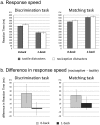Controlling attention to nociceptive stimuli with working memory
- PMID: 21687745
- PMCID: PMC3110248
- DOI: 10.1371/journal.pone.0020926
Controlling attention to nociceptive stimuli with working memory
Abstract
Background: Because pain often signals the occurrence of potential tissue damage, a nociceptive stimulus has the capacity to involuntarily capture attention and take priority over other sensory inputs. Whether distraction by nociception actually occurs may depend upon the cognitive characteristics of the ongoing activities. The present study tested the role of working memory in controlling the attentional capture by nociception.
Methodology and principal findings: Participants performed visual discrimination and matching tasks in which visual targets were shortly preceded by a tactile distracter. The two tasks were chosen because of the different effects the involvement of working memory produces on performance, in order to dissociate the specific role of working memory in the control of attention from the effect of general resource demands. Occasionally (i.e. 17% of the trials), tactile distracters were replaced by a novel nociceptive stimulus in order to distract participants from the visual tasks. Indeed, in the control conditions (no working memory), reaction times to visual targets were increased when the target was preceded by a novel nociceptive distracter as compared to the target preceded by a frequent tactile distracter, suggesting attentional capture by the novel nociceptive stimulus. However, when the task required an active rehearsal of the visual target in working memory, the novel nociceptive stimulus no longer induced a lengthening of reaction times to visual targets, indicating a reduction of the distraction produced by the novel nociceptive stimulus. This effect was independent of the overall task demands.
Conclusion and significance: Loading working memory with pain-unrelated information may reduce the ability of nociceptive input to involuntarily capture attention, and shields cognitive processing from nociceptive distraction. An efficient control of attention over pain is best guaranteed by the ability to maintain active goal priorities during achievement of cognitive activities and to keep pain-related information out of task settings.
Conflict of interest statement
Figures




Similar articles
-
Shielding cognition from nociception with working memory.Cortex. 2013 Jul-Aug;49(7):1922-34. doi: 10.1016/j.cortex.2012.08.014. Epub 2012 Sep 1. Cortex. 2013. PMID: 23026759
-
The role of working memory in the attentional control of pain.Pain. 2011 Feb;152(2):453-459. doi: 10.1016/j.pain.2010.11.024. Pain. 2011. PMID: 21238855
-
Working memory contents revive the neglected, but suppress the inhibited.Cognition. 2015 Dec;145:116-21. doi: 10.1016/j.cognition.2015.08.012. Epub 2015 Sep 7. Cognition. 2015. PMID: 26355831
-
Interactions between attention and working memory.Neuroscience. 2006 Apr 28;139(1):201-8. doi: 10.1016/j.neuroscience.2005.08.023. Epub 2005 Dec 1. Neuroscience. 2006. PMID: 16324792 Review.
-
Visual working memory as visual attention sustained internally over time.Neuropsychologia. 2011 May;49(6):1407-9. doi: 10.1016/j.neuropsychologia.2011.01.029. Epub 2011 Feb 2. Neuropsychologia. 2011. PMID: 21295047 Review.
Cited by
-
An incremental dual-task paradigm to investigate pain attenuation by task difficulty, affective content and threat value.PLoS One. 2018 Nov 9;13(11):e0207023. doi: 10.1371/journal.pone.0207023. eCollection 2018. PLoS One. 2018. PMID: 30412604 Free PMC article.
-
Management of dental anxiety via distraction technique.J Clin Exp Dent. 2021 Apr 1;13(4):e350-e356. doi: 10.4317/jced.57660. eCollection 2021 Apr. J Clin Exp Dent. 2021. PMID: 33841733 Free PMC article.
-
Impaired spatial memory performance in a rat model of neuropathic pain is associated with reduced hippocampus-prefrontal cortex connectivity.J Neurosci. 2013 Feb 6;33(6):2465-80. doi: 10.1523/JNEUROSCI.5197-12.2013. J Neurosci. 2013. PMID: 23392675 Free PMC article.
-
Parabrachial Nucleus Activity in Nociception and Pain in Awake Mice.J Neurosci. 2023 Aug 2;43(31):5656-5667. doi: 10.1523/JNEUROSCI.0587-23.2023. Epub 2023 Jul 14. J Neurosci. 2023. PMID: 37451980 Free PMC article.
-
No evidence for an effect of selective spatial attention on the development of secondary hyperalgesia: A replication study.Front Hum Neurosci. 2022 Nov 3;16:997230. doi: 10.3389/fnhum.2022.997230. eCollection 2022. Front Hum Neurosci. 2022. PMID: 36405082 Free PMC article.
References
-
- Eccleston C, Crombez G. Pain demands attention: A cognitive-affective model of the interruptive function of pain. Psychol Bull. 1999;125:356–366. - PubMed
-
- Legrain V, Van Damme S, Eccleston C, Davis KD, Seminowicz DA, et al. A neurocognitive model of attention to pain: Behavioral and neuroimaging evidence. Pain. 2009;144:230–232. - PubMed
-
- Legrain V, Perchet C, García-Larrea L. Involuntary orienting of attention to pain. Neural and behavioral signatures. J Neurophysiol. 2009;102:2423–2434. - PubMed
-
- Vancleef LMG, Peters ML. The interruptive effect of pain on attention. J Pain. 2006;7:21–22. - PubMed
-
- Legrain V, Iannetti GD, Plaghki L, Mouraux A. The Pain Matrix reloaded. A salience-detection system for the body. Prog Neurobiol. 2011;93:111–124. - PubMed
Publication types
MeSH terms
LinkOut - more resources
Full Text Sources
Medical

